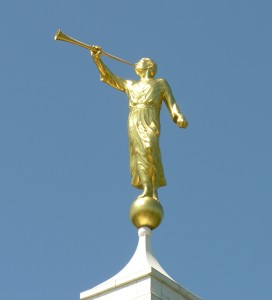After five and a half years the Nashville Tennessee Temple is finally completed and members are grateful. The original site for the temple was changed, because after three years of trying to gain approval, a court of law decided not to approve zoning, and the Mormon Church did not appeal the decision.“We were surprised at the opposition in Forest Hills,” said Allan Erb chairman of the local temple-site committee. “Our experience has been that the temples have become attractive and appreciated assets to the communities wherever they’ve been built. We are disappointed that our temple will not be part of the Forest Hills religious community.”1Instead, a smaller Mormon temple than was planned was built next to an existing meetinghouse about twenty miles southwest of Nashville. The temple’s exterior is constructed from Imperial Danby white marble and has a single spire topped with the familiar statue of the angel Moroni. It will serve 13,000 members in the Tennessee area. Elder John K. Carmack of the Seventy during the groundbreaking ceremony declared, “It’s the faith, righteousness and prayers of the people in this area that brought the temple here.” 2 Elder John K. Carmack of the Seventy during the groundbreaking ceremony declared, “It’s the faith, righteousness and prayers of the people in this area that brought the temple here.” 2
During the temple open house held May 6-13, 2000, almost 25,000 people toured the temple. Non-members were given a chance to see what a Mormon temple looks like inside. Buryl McClurg, the newly called temple president said, “They have been so good and so kind, so generous in their comments about what they see. I think it’s been a unifying kind of experience.” His wife Daine McClurg added, ““I heard people say as they went out that they felt different when they were inside. That’s a lot of what it’s all about—the feeling of the Spirit.” 3 Members would testify that the Holy Spirit is what sets the temple apart from other buildings. After a temple is dedicated, only those who are living their lives in alignment with gospel principles are allowed to enter, so the Spirit is always present in the temple. There is no discord, anger, or worldly influence to disrupt the influence of the Holy Ghost. Mormon temples are places of peace and harmony where members of the Church go to learn more about God and participate in eternal ordinances such as sealings, baptisms, and endowments. A sealing ordinance is what unites families together for time and for all eternity. Couples who are married in the temple are promised eternal marriage, not just till death do they part. Sealings are also performed for those who have died, giving them a chance to be joined as a family. The endowment is a series of covenants that are made between a person and God. Each person promises to keep the commandments and serve the Lord, and He in return promises eternal life in His presence. After receiving his own endowment, a member can stand as proxy for a deceased person and make the necessary covenants. The deceased person can then choose to accept those covenants, or not. Baptisms in behalf of those who are deceased are performed in temples. Members are baptized in proxy in a baptismal font, which stands on the back of twelve sculptered oxen, representing the twelve tribes of Israel. The deceased person who has been baptized by proxy then has the choice to accept the baptism or not. (See Inside Mormon Temples to see a temple baptismal font.) James E. Faust dedicated the Nashville Tennessee temple on 21 May 2000. “This sacred structure stands as a monument before the world of our belief in the immortality of the human soul and that a great work is going forward on the other side of the veil to bring blessings to those who will accept the ordinances which will be performed in their behalf in this Thy house,” 4 said President Faust in the dedicatory prayer, for the ultimate purpose of Mormon temples is “to bring to pass the immortality and eternal life of man,” 5 both living and deceased. For more information about Mormon temples visit the sites below: LDS Temples – Mormon Temples – Salt Lake Temple (1) News of the Church,” Ensign, July 1998, 76 |
